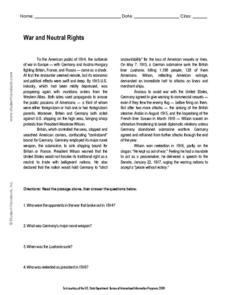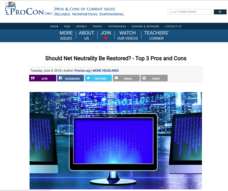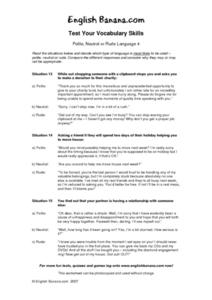Curated OER
Lesson Plan: The Net Neutrality Debate
Should Internet users who send data-heavy content pay higher fees than those who are involved in activities, like sending an email, that have less content? This question is at the heart of the Net Neutrality debate. After watching a PBS...
Student Handouts
War and Neutral Rights
Teach your class about neutral rights with a brief reading selection and related questions. Pupils read the passage and answer the four questions on the bottom half of the page. Useful for a homework assignment or a quick warm-up, this...
Curated OER
Gender Neutral Language
Tackling gender issues in your class? This online quiz about gender neutral language might be for you! Learners re-write 10 sentences using gender neutral language. When they have finished re-writing each sentence, they can check their...
ProCon
Net Neutrality
Should net neutrality be restored? Scholars prepare for a class debate on the topic using the included website. After reading a brief introduction to the issue, they review the main pros and cons in an attempt to arrive at an informed...
Curated OER
Lesson 3: U.S. Neutrality and the War in Europe, 1939-1940
Students examine the U.S. neutrality policies that preceded American involvement in World War II. In this World War II lesson, students explore the events in Europe from 1939 to 1940 and Roosevelt's decision to give military aid to Britain.
Curated OER
Legislating neutrality
Eleventh graders explore the Merchants of death thesis. In this American History lesson, 11th graders explain the Neutrality Laws. Students assess the overall effectiveness of US neutrality policy.
Curated OER
Polite, Neutral Or Rude Language- Introduction
In this language arts worksheet, students are introduced to the difference between polite, rude or neutral language. Students read the information paragraphs about when it is appropriate to use each type of language.
National Endowment for the Humanities
Lesson 2: The United States, France, and the Problem of Neutrality, 1796–1801
While the French Revolution could be considered inspired by the American Revolution, it created thorny problems for the new United States. Should the United States get involved and be drawn into a European drama? Was the US strong...
Curated OER
Polite, Neutral Or Rude Language 4
In this language arts instructional activity, 5th graders learn the difference between polite, neutral and rude responses to oral requests. Students read 3 situations and 3 possible responses. Students compare them and decide which is...
Institute for Humane Education
Selling "Boy" and "Girl"
Monster trucks, action figures, and video games. Are these toys designed for boys or girls? Scholars work in small groups to find and categorize examples of boy and girl toys from catalogs. Next, learners analyze the two sets of pictures...
Newseum
The Press and the Presidency: Friend or Foe? How the President Is Portrayed
In theory, news reports should be fair and unbiased. Young journalists test this theory by selecting a current news story covered by various media outlets about the President of the United States. They then locate and analyze five...
Curated OER
Whose Side Are You On?
Learners role play, persuading and staying neutral during arguments. In this viewpoint activity, students examine the viewpoints of soldiers in the Spanish-American War and role play. After a discussion, some learners try to persuade the...
National Endowment for the Humanities
Chronicling America: Uncovering a World at War
As part of a study of World War I, class members read newspaper articles from the time that urge American involvement, non-involvement, or neutrality. Using the provided worksheet, groups analyze the articles noting the central argument...
Facing History and Ourselves
How Journalists Minimize Bias
Class members are challenged to write a neutral news story about the events they observe in a short video. After sharing their stories in groups and discussing the different perceptions, the class concludes with a video of...
National Endowment for the Humanities
Lesson 1: The United States Confronts Great Britain, 1793–1796
After the Revolutionary War, the success of the United States was far from guaranteed. Foreign powers coveted the new land, and Great Britain challenged American sovereignty. Learners consider the challenges facing the new nation using...
Curated OER
Civil War Perspectives
Fifth graders have a debate and defend one of the three different perspectives of the Civil War. In this Civil War lesson plan, 5th graders defend either the North, the South, or the Neutral perspectives.
Bismarck Public Schools
Jefferson & the Louisiana Purchase
After learning about the Louisiana Purchase, assess your class members' understanding of Napoleon Bonaparte's involvement, states included in the purchase, and important key terms (i.e. neutrality, corps of discovery, etc.) associated...
Humanities Texas
Primary Source Worksheet: Letter from George Washington to the Cabinet
Analyze the significance of George Washington's letter to his cabinet in which he sets forth a tradition of neutrality in wartime for the United States.
Curated OER
Woodrow Wilson and American Involvement in the Great War
Students examine American involvement in World War I. In this World War I instructional activity, students investigate Wilson's policy of neutrality as they read excerpts from his messages to Congress. Students respond to questions...
Curated OER
Kentucky in the Civil War
Seventh graders consider how Kentucky was involved in the Civil War. In this American Civil War lesson, 7th graders view PowerPoint presentations on the topic and then discuss the state's neutrality policy and eventual secession....
US Institute of Peace
Mediating Conflict
Two's a negotiation, but three's a mediation! Demonstrate the differences between the two processes through a role-playing lesson. The activity familiarizes pupils with the role of a mediator and examines the types of situations that...
KindAPUSH
The Jungle Document Exercise
Go with your gut! Scholars read excerpts from The Jungle by Upton Sinclair and record their initial feeling from the reading as strong positive, positive, neutral, negative, or strong negative. They then discuss how their responses...
Center for History Education
Breaking the Great League of Peace and Power: The Six Iroquois Nations During and After the American Revolution
What happens when you can't remain neutral? An informative lesson explores the impact of the American Revolution on the Iroquois Nations. Scholars learn about the six Iroquois nations and their treaty with the newly formed American...
Curated OER
Simulation: Revolutionary Town Hall Meeting
Secondary historians simulate events leading up to the American Revolution. They assume the roles of patriots, loyalists, or neutrals in a town meeting set prior to the Revolution. As Patriots and Loyalists make their arguments, neutrals...























